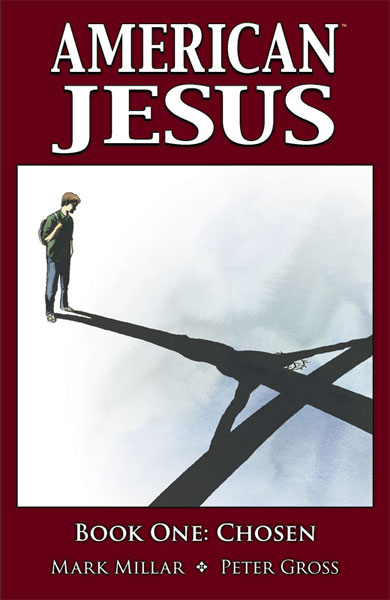American Jesus Book One: Chosen
By Andy Frisk
April 7, 2009 - 19:25
Image Comics
Writer(s): Mark Millar
Penciller(s): Peter Gross
Colourist(s): Jeanne McGee
Letterer(s): Cory Petit
ISBN: 978-160706006-2
$9.99 US
Being raised a Catholic and attending Catholic school for 3 years as a kid, I kept looking back up and over my shoulder for the lightening bolt that was sure to strike me while reading AMERICAN JESUS. While its been 23 years since I went to Mass every Friday at 9am as a part of the school day and have since gone through my own personal Protestant, then semi-agnostic (or was it Gnostic?) Reformations, that good ole’ fear of The Lord, no candy during Lent, transubstantiation of the bread and wine, etc. etc. is hard to drop from one’s psyche. It wasn’t until I reached the end of BOOK ONE: CHOSEN that I stopped subconsciously fearing the lightening bolt and very consciously fearing my reaction to the tale and how it so easily mislead me.

This involuntary head spinning lightening bolt check wasn’t a bad thing brought on by reading AMERICAN JESUS. It was part of what made BOOK ONE so great. Millar weaves a tale about a young boy in America who is dealing with all the things most early adolescent boys do: girls, raging hormones, girls, overbearing teachers, girls, grades, school yard bullies, and, oh, did I mention, girls? Jodie (our American Jesus) has more than just the usual early teen dramas to worry about. After an 18 wheeled truck and its trailer falls on him and he walks away without a scratch, then discovers that he can heal the sick, knows everything about every subject in school, and can change water into wine, his mother informs him that he’s not a mutant, as he hilariously guesses, but rather the Son of God in His Second Coming incarnation.
Jodie begins to attract a following and pulls off other Christ-like miracles, but doesn’t attract, strangely enough, a media following. We later learn that this is by design. It is here that we begin to get the sense that something isn’t what it seems. It would be a mortal sin to explicitly give away the story’s ultimate twist here for those who have yet to read this work but suffice to say that it is definitely worth the reading.
Getting back to that aforementioned lightening bolt I kept looking for, throughout the work Millar and Gross supply us with a deluge of Christian imagery. Telephone and power line poles that line the background of certain panels are reminiscent of the three crosses on Golgotha, Jodie conducting healings on the town’s local mount, even a superimposed image of Gustave Dore’s wood carving of Michael’s driving Lucifer from Heaven all help lull the reader into a certainty that we are reading the story of the returned Christ. When one reaches the end of the book though a careful re-reading of the images imbedded in the panels throughout the work reveal a very different story. AMERICAN JESUS BOOK ONE contains an afterword titled “The Gospel According to Millar and Gross: Occult Symbols and Hidden Meanings” where Millar and Gross take us on a trip back through the volume and show the readers various hidden symbols and images. There’s enough hidden stuff and easily overlooked signs to give away the ending as far back as a few pages into Chapter One.

It is the overwhelming sense the reader gets as one continues through the story that, while there is a lot of seemingly flippant and blasphemous tossing around of the Jesus story’s aspects, that Jodie, our American Jesus, really does mean well and starts to take the signs and powers inherent in and of his identity seriously. Seriously enough to go out on a limb and perform a resurrection that is sure to draw way too much attention to himself in order to help restore the faith of a doubting priest. In turn, we the readers begin to believe and warm to this young Savior and here is where we fall, just as Millar intends us to.
Millar, willingly or not, borrows a technique John Milton (speaking of Protestant Revolutions or should I say Revolutionaries) employs in
It is this powerful reversal and repudiation of our beliefs about and feeling for these characters that, in part, makes both works the literary tales they are. In Millar’s work, the reader, like myself, goes from looking over his shoulder, waiting for God to strike him down for reading this modern day take on the sacred story of His Son, related in a pop art form with all its post modern humor and irony intact, to actually believing in the message of the tale, that faith is rewarded even when it is nearly lost, to horror at being so easily deceived by the few good works of a false hero when their true nature is revealed. Millar provides us with a powerful message. Wolves often come in sheep’s clothing and not every one who cries out in righteousness or performs works of so called righteousness is what they seem and they can easily deceive us with their smoke, mirrors and “miracles.” From the televangelist on down to the local parishioner to the highest officer maintaining the highest office in the land, all may not be what they seem and a careful reading of the signs and boasts, like those dropped by Millar and Gross throughout AMERICAN JESUS, may reveal more truth of character than the actual words of these would be messiahs. A valid message delivered by a valid work for our media savvy and polished times.
Rating: 10/10
Related Articles:
Mark Millar Bashes Potential Justice League Movie
Witchblade Demon Reborn with New Material from Mark Millar and Jae Lee
Mark Millar’s Clint #1 sells out, second printing announced by Titan!
Mark Millar's CLiNT #2
Mark Millar's CLiNT #1
New magazine from Kick-Ass creator Mark Millar
Alan Who? Mark Millar and Kick Ass Still Rule
Marvel Presents Mark Millar's Trinity
At the Top of His Game... Mark Millar and WANTED
